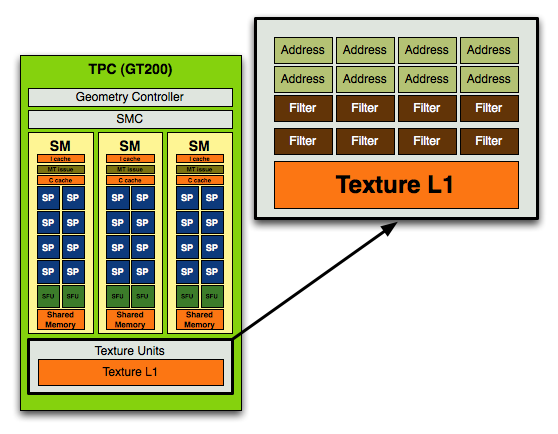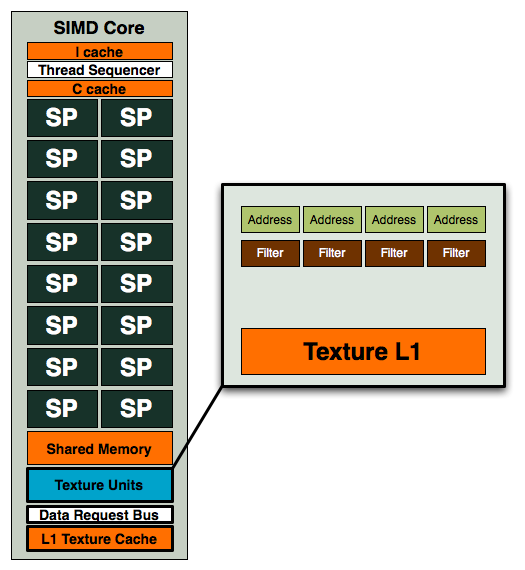The Radeon HD 4850 & 4870: AMD Wins at $199 and $299
by Anand Lal Shimpi & Derek Wilson on June 25, 2008 12:00 AM EST- Posted in
- GPUs
That Darn Compute:Texture Ratio
With its GT200 GPU, NVIDIA increased compute resources by nearly 90% but only increased texture processing by 25%, highlighting a continued trend in making GPUs even more powerful computationally. Here's another glance at the GT200's texture address and filter units:

Each TPC, of which there are 10, has eight address and eight filter units. Now let's look at RV770:

Four address and four filter units, while AMD maintains the same 1:1 address-to-filter ratio that NVIDIA does, the ratio of compute-to-texture in RV770 is significantly higher.
| AMD RV770 | AMD RV670 | NVIDIA GT200 | NVIDIA G92 | |
| # of SPs | 160 | 64 | 240 | 128 |
| Texture Address/Filter Units | 40 / 40 | 16 / 16 | 80 / 80 | 64 / 64 |
| Compute to Texture Ratio | 4:1 | 4:1 | 3:1 | 2:1 |
The table above illustrates NVIDIA's trend of increasing the compute to texture ratio from 2:1 in G92 to 3:1 in GT200. AMD arguably overshot with RV670 and its 4:1 ratio and thus didn't need to adjust it with RV770. Even while staying still at 4:1 with RV770, AMD's ratio is still more aggressively geared towards compute than NVIDIA's is. That does mean that more texture bound games will do better on NVIDIA hardware (at least proportionally), while more compute intensive games may do better on RV770.
AMD did also make some enhancements to their texture units as well. By doing some "stuff" that they won't tell us about, they improved the performance per mm^2 by 70%. Texture cache bandwidth has also been doubled to 480 GB/s while bandwidth between each L1 cache and L2 memory is 384 GB/s. L2 caches are aligned with memory channels of which there are four interleaved channels (resulting in 8 L2 caches).
Now that texture units are linked to both specific SIMD cores and individual L1 texture caches, we have an increase in total texturing ability due to the increase in SIMD cores with RV770. This gives us a 2.5x increase in the number of 8-bit per component textures we can fetch and bilinearly filter per clock, but only a 1.25x increase in the number of fp16 textures (as fp16 runs at half rate and fp32 runs at one quarter rate). It was our understanding that fp16 textures could run at full speed on R600, so the 1.25x increase in performance for half rate texturing of fp16 data makes sense.
Even though fp32 runs at quarter rate, with the types of texture fetches we would need to do, AMD says that we could end up being external memory bandwidth bound before we are texture filtering hardware bound. If this is the case, then the design decision to decrease rates for higher bit-depth textures makes sense.
| AMD RV770 | AMD RV670 | |
| L1 Texture Cache | 10 x 16KB (160KB total) | 32KB |
| L2 Texture Cache | I can has cache size? | 256KB |
| Vertex Cache | ? | 32KB |
| Local Data Share | 16KB | None |
| Global Data Share | 16KB | ? |
Even though AMD wouldn't tell us L1 cache sizes, we had enough info left over from the R600 time frame to combine with some hints and extract the data. We have determined that RV770 has 10 distinct 16k caches. This is as opposed to the single shared 32k L1 cache on R600 and gives us a total of 160k of L1 cache. We know R600's L2 cache was 256k, and AMD told us RV770 has a larger L2 cache, but they wouldn't give us any hints to help out.










215 Comments
View All Comments
StevoLincolnite - Wednesday, June 25, 2008 - link
Of course it can, There are benchmarks isn't there?Seriously ANY Direct X 9 card can run Crysis, The Quality and Performance is a different matter.
Inkjammer - Wednesday, June 25, 2008 - link
I have a 9800 GX2 in my primary gaming rig, but I've been debating on what card to drop into my Photoshop/3DS Max art rig. I've been waffling over it for some time, and was going to settle on an 8800GT... but after seeing this, my mind's set on the 4850. It definitely appears to offer more than enough power to handle my art apps, and allow me to use my second PC a gaming rig if need be... all without breaking the bank.This'll mark my return to buying ATI hardware since the X800 was king.
weaksideblitz - Wednesday, June 25, 2008 - link
this is a welcome development although im only buying a 4850 :)Locutus465 - Wednesday, June 25, 2008 - link
Very much so, actually from where I sit I think all AMD really needs to do is get a SAM2+ CPU out there that can compete with intel at least similarly to how this card competes with nvida and they'd have one hell of a total platform solution right now. As for upgrading my vid card... I just finished upgrading to the Phenom 4x and Radeon 3870 so I'll be sticking with that for a while. Quite honestly that platform can pretty much run anything out there already as it is, so I'm feeling pretty confident my current setup will last a couple years at least.Lifted - Wednesday, June 25, 2008 - link
Ditto. If I can get a 4850 for ~$150 or so, that's what I'm doing as well.billywigga - Friday, August 29, 2008 - link
where are you getting it from best buy or somethingClauzii - Wednesday, June 25, 2008 - link
That leaves 50 for a better cooler ;)Lifted - Wednesday, June 25, 2008 - link
Is there any reason the first pages of benchmarks have SLI setups included in the charts, but you wait until the end of the article to add the CF? I'd think it would make the most sense to either include both from the start or hold both until the end.Anand Lal Shimpi - Wednesday, June 25, 2008 - link
The original idea was to format it like the 4850 preview, keep things simple early on but offer SLI/CF graphs later in the article for those who wanted them.It looks like in the mad rush to get things done it didn't work out that way, I'll see if it's possible to clean it all up but right now we've got a lot of other minor touchups to do first :)
Take care,
Anand
TechLuster - Wednesday, June 25, 2008 - link
Anand,I really like your idea of "keeping things simple early on" by only including configurations that us mere mortals can afford at first (say, all single-GPU configs plus "reasonable" multi-GPU configs less than ~$400 total), and then including numbers for ultra high-end multi-GPU configs at the end (mainly just for completeness and also for us to drool over--I doubt too many people can afford more than one $650 card!).
Anyway, great job on the review as always. I think you and Derek should get some well-deserved rest now!
-TL